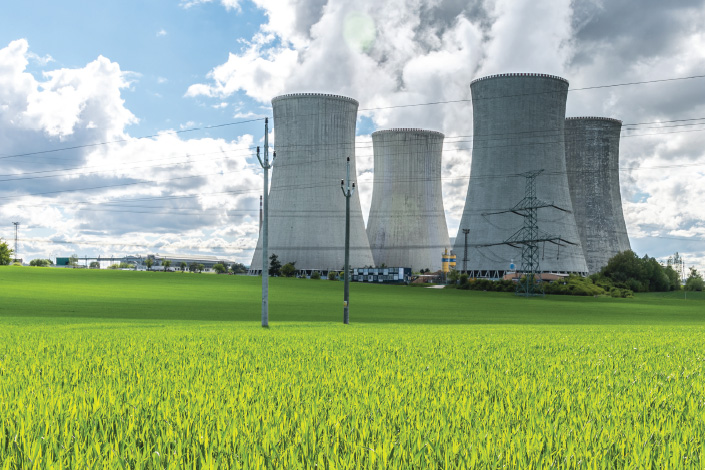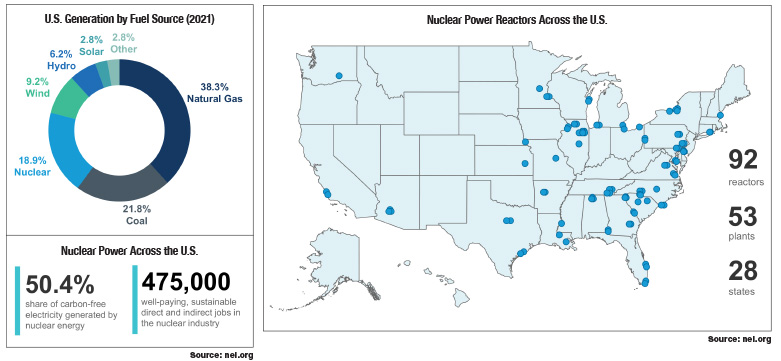By Cathy Bonnstetter

West Virginia is poised to enhance its reputation as an energy powerhouse. Empowered with changes in both federal and state laws, innovative thinkers and political leaders are preparing to welcome nuclear energy as part of the state’s energy portfolio, a move that can bring sustainable jobs with life-changing wages and possibilities. State leaders are quick to explain that the Mountain State’s new energy package will be a coexistence of nuclear and coal powered energy, along with wind and solar energy.
“We have to understand where nuclear energy fits and what its role is,” says Marshall University President Brad Smith, says. “Nuclear energy is very clean and reliable. It needs to be part of the portfolio, but it is not intended to replace everything. As a state, we are proud of our fossil fuel legacy. Historically, those fuels have done very well, continue to play a vital role today and will continue to play a vital role in the future.”
In 1996, West Virginia banned the ability to build nuclear power plants in the state; however, in January 2022, the Legislature repealed the 25-year-old ban. Repealing the ban was just the first step toward rendering nuclear energy a viable source in the Mountain State.
“The ban on nuclear was a combination of some concerns. What if there is a natural disaster or catastrophic event? Also, we had other sources that we focused our time and our resources on,” Smith says. “Now we have a more inclusive approach to energy—it doesn’t need to be either/or. This is a natural place in time for us to move beyond that. By removing the 25-year ban, our governor and Legislature opened the opportunities for people to come in and help us develop this nuclear power infrastructure in the state.”
Smith, former CEO of Intuit and co-founder of the Wing 2 Wing Foundation—an organization whose vision focuses on advancement of the state of West Virginia and its citizens through education, entrepreneurship and the environment— says he has always been a fan of the All of the Above Energy Plan that dates back to the Obama administration. Senator Joe Manchin, chairman of the U.S. Senate Committee on Energy and Natural Resources, also agrees that the Mountain State is ready to embrace nuclear possibilities.
“America’s energy future will rely on innovation, not elimination,” Manchin says. “Advanced nuclear power will be a critical component of our energy security and independence for decades to come. The Inflation Reduction Act, CHIPS and Science Act, Bipartisan Infrastructure Law and Energy Act of 2020 all included provisions providing substantial incentives and programs to support the deployment of nuclear power across the U.S.”
Smith says by providing tax credits, the Inflation Reduction Act can propel the state into the nuclear energy arena.
“It has been estimated that approximately $240 million in investments can come into West Virginia as a result of these tax credits,” Smith says. “The Inflation Reduction Act creates the incentive for people to come in and jump over that hurdle of capital investment up front and create a long-term benefit for the company involved and the state.”
The Inflation Reduction Act includes multiple incentives for the nuclear energy sector, from production tax credits for existing reactors to incentivizing advanced nuclear deployment, according to Kathryn Huff, Ph.D., assistant secretary for nuclear energy at the Department of Energy (DOE). Players in the nuclear field determine which of the tax credit plans works for them, but both plans include a bonus for states such as West Virginia.
“Both incentive plans include a 10% bonus if the power plant is built at a brownfield site or a fossil energy community—ensuring social and energy justice for states such as West Virginia,” Huff says.
One of the cons of nuclear plants is their hefty price tags. However, many U.S. companies are developing advanced technologies that will make the reactors more affordable to build and operate. These nuclear vendors are planning to demonstrate their reactors within the decade, according to Huff.
West Virginia has the answer to some of those financial woes, in part because of its fossil fuel legacy.
“A recent DOE report also found that 80% of retired and retiring U.S. coal plant sites are suitable for advanced reactor power sites,” Huff says. “This coal-to-nuclear transition can leverage some of the existing infrastructure and workforce at these plants to build a new clean energy economy and keep jobs in the local area. The study also estimates that replacing retired coal capacity with nuclear could increase regional economic activity by as much as $275 million and add 650 new, permanent jobs to the community.”
In an effort to put some investment muscle behind the politics of nuclear power, Manchin invited his friend, tech innovator and billionaire Bill Gates, to the Mountain State in January to tour a closed coal-fired power plant in Glasgow, the Kanawha River Plant. Manchin and Gates met with Smith, as well as other federal and state officials and various stakeholders, to discuss the possibilities the Inflation Reduction Act and these former coal-fired plants bring to the nuclear table. Smith says the repurposing of already built sites is just one of many reasons West Virginia is poised to take the nuclear plunge.
“We have a legacy of being an energy state, with coal and natural gas, then recently with wind and solar,” he says. “We have the people with the skills and the talent. We are energy literate in that we understand the role energy plays in the economy. Many of the skills we already possess apply equally across other forms of energy. Our history, infrastructure and talent all come into play.”
The jobs that nuclear energy creates and sustains make nuclear possibilities especially exciting for the state and for West Virginians in several different ways.
“Data suggests that a nuclear power plant creates more jobs than any other source of power in the nation,” Smith says. “The variety of jobs is incredible. From the construction jobs that build it to specialists such as engineers, chemists, scientists, safety officers and operators, as well as technicians, accountants and welders, the jobs literally run the gamut; it is a very inclusive employment opportunity.”
It is not just the variety or quantity of jobs in the nuclear field that make it so appealing in West Virginia. It is also the quality of what those jobs offer to individuals and their communities.
“The data that I have seen is wages 30% higher than local averages,” Smith says. “What we would have is a power plant that employs more people, more types of people and pays them as much as 30% higher than other wages in the area. I think that will create a real opportunity for West Virginians.”
In 2021, nuclear energy provided enough electricity to power more than 70 million homes according to the DOE’s Office of Nuclear Energy.
“The U.S. operates the largest fleet of nuclear reactors in the world, which generate 19% of the nation’s electricity and half of its clean, emissions-free energy, making it the largest domestic source of clean energy,” Huff says. “Advantages of nuclear power include a small physical footprint, high energy density reliability and carbon avoidance. Beyond electricity, commercial reactors can be used to power desalination plants, provide heat for processes such as metal refining and even generate hydrogen as a clean burning alternative fuel for vehicles.”
West Virginia is the only state east of the Mississippi that does not have a nuclear power facility.
Illinois leads the nation in the generation of electricity from nuclear energy, with 11 reactors at six plants, according to the U.S. Energy Information Administration. More than half of the states in the union make electricity with nuclear power.
However, nuclear power does come with a specific set of issues. The spent nuclear fuel to power the reactors is hazardous and must be managed properly, and although problems at nuclear facilities are infrequent, they could be catastrophic, says Smith.
The DOE is working diligently to drive the research, development and deployment of innovative nuclear technologies, systems and practices that will help improve the technology, according to Huff. Meanwhile, Mountain State leaders are looking to nuclear energy to reenergize the state’s energy sector, repurpose old infrastructure and infuse much needed capital into coal weary communities.
“We have a skilled workforce that can build things with their hands,” Smith says. “We have incredible talent to develop the science behind it, and we have a workforce that is energy literate. We understand what it takes to transform something into energy that in turn creates power for the economy. When you put who we are and how we celebrate work, both with our hands and minds, and also the fact that we speak the language and understand the science behind it, we are a perfectly trained workforce for this kind of energy.”









